BP (BP.) revealed earnings and profit fell over the three months to the end of June, but results were stronger than consensus estimates, sending shares higher. BP proved an exception to peers who have already reported strong year-over-year gains.
Cash flow generation, excluding the impact of Gulf of Mexico payments, improved from the first quarter and was sufficient to cover capital spending and the cash portion of its dividend, demonstrating that BP is moving in the correct direction.
BP expects the continued addition of new project start-ups to drive production growth and cost reductions leading to greater cash flow generation and a cash dividend not financed by debt – so long as oil remains at $50-55 per barrel in 2018.
We think the upper end of that range is possible, but also see a risk of oil prices averaging $45 per barrel next year, meaning the scrip – or provisional dividend – is likely to stay until 2019.
Second-quarter adjusted earnings fell to $684 million from $720 million last year as downstream earnings slipped and upstream earnings were negatively affected by higher exploration write-offs in Angola, which also were not tax deductible.
Upstream adjusted earnings increased to $710 million from $29 million last year on higher production and improved commodity prices. Downstream earnings fell to $1.4 billion from $1.5 billion, largely on lower trading results. Operating cash flow, excluding Gulf of Mexico payments, improved to $6.9 billion from $5.3 billion last year and $4.4 billion in the first quarter.
Gulf of Mexico Disaster Still Weighs on BP
BP also has the burden of its Gulf of Mexico payments, which drove gearing to 29% from 25% last year, the upper end of its targeted range of 20%-30%. Admittedly, the increase in debt was partially a mismatch in timing between payments and asset sale proceeds that are expected later in the year. Payments of $4.5 billion-$5.5 billion this year should fall to $2 billion next year and $1 billion thereafter.
While BP can fund these payments with annual asset sales, this remains a liability that its peers don’t have. All that said, BP is improving its position by increasing production, reducing costs, and increasing downstream earnings contribution, which should reduce its break-even over time.
We think these efforts are largely reflected in the share price, however. We plan to incorporate the latest results and long-term guidance into our model but do not anticipate a change to our fair value estimate or moat rating.




























